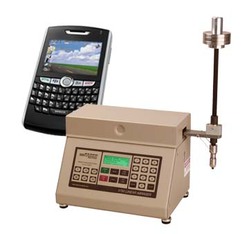Transparent Materials (Linear Mar Test)
SITUATION:
Historically the Taber Rotary Abraser has been utilized to evaluate abrasion and mar damage to transparent materials. Following the procedure described in test method ASTM D1044, 100mm square flat specimens are subjected to rotary rubbing action under controlled conditions of pressure and abrasive action. The test specimen, mounted on a turntable platform, turns on a vertical axis, against the sliding rotation of two abrading wheels. Resistance to abrasion is evaluated by using a Hazemeter to measure the change in haze. Despite its popularity with glass and plastic producers, the Rotary Abraser does not permit an operator to test contoured parts or specimens smaller than 100mm square. Thus, for finished product such as handheld devices or eyewear protection, a special coupon must be prepared or an alternative test method utilized. In 1999, Taber Industries introduced the Linear Abraser to satisfy this need.
ANALYSIS:
In the past 10+ years, Taber has received numerous customer requests to conduct abrasion testing on a variety of products incorporating transparent materials. Utilizing a modified approach based on ASTM D1044, we have had promising results in differentiating various materials / coatings. This modified approach utilizes the Taber Linear Abraser 5750 with the T-Slot Universal Table, along with the CS-10F Wearaser or MIL 12397 Eraser (for eyewear). Other test parameters include a stroke length of 1 inch; speed of 30 cycles per minute; and test load of 900g. As a general rule, all samples are visually inspected prior to testing so the operator can identify any potential scratch or mar damage that may be present.
A simplified test procedure is shown below:
- Condition samples for 24 hours in a standard laboratory environment (22 °C ±3 °C and RH 50% ±5%).
- Clean both sides of sample using a lint free cloth and Isopropanol alcohol.
- Using a Hazemeter, record the initial haze. (Note: the specimen area to be tested should be held against the port of the Hazemeter, with a customized mask to limit the light beam to the width and length of the abraded track.)
- Secure the sample to the specimen holder, ensuring the area to be tested is lined up with the abradant. (Note: the Laser indicator is used for this purpose.)
- Reface the abradant using an ST-11 Refacing Stone for 5 cycles (see note).
- Commence testing for 20 cycles.
- Remove specimen, and clean according to step 2.
- Using a Hazemeter and the “mask” described in step 3, record the final haze.
- Subtract the Initial Haze from the Final Haze to report change in haze caused by abrasion.
NOTE: Abrasion tests may be subject to variation due to changes in the abradant during the course of the test. Depending on abradant type and test specimen, the abradant may change (i.e. become clogged) due to the pick-up of coating or other materials from test specimens. To reduce this variation, the abradant should be resurfaced prior to conducting tests and at regularly defined intervals if necessary.
As an alternative to reporting change in haze, the operator may also report findings from a visual inspection. Each sample should be inspected under magnification (e.g. 5x magnifier) and assigned a rating (see below as an example).
| 1 = No Damage 2 = Some individual scratches visible under magnification, no apparent marring (hazing) of surface 3 = Tightly spaced scratches, resulting in a minimal change in marring (haze) 4 = Noticable change in appearance, but surface is still transparent 5 = Surface is translucent, but no longer transparent |
 BENEFIT:
BENEFIT:
When a 'historical' approach is not viable due to sample dimensions, alternative solutions may be already be available. Although there is no correlation to prove the equivalency of test results generated with Taber Rotary Abraser versus the Taber Linear Abraser, the test data generated by the above procedure does provide useful information that can be used to: assist with design decisions; monitor quality control; and/or evaluate material solutions.


